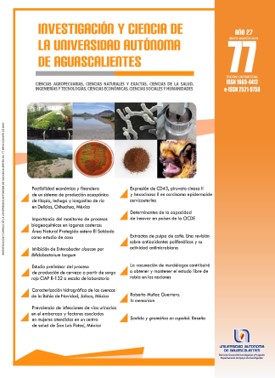The importance of monitoring biogeochemical processes in coastal lagoons: Estero El Soldado Protected Natural Area as a case study
DOI:
https://doi.org/10.33064/iycuaa2019772087Keywords:
biogeochemical processes, nutrients fluxes, net ecosystem metabolism, coastal lagoonsAbstract
This contribution presents estimates of nutrient fluxes and net metabolism in a pristine coastal lagoon of the Gulf of California. During spring, water variables were sampled in the lagoon and the adjacent sea. The biogeochemical model proposed by the LOICZ program (Land-Ocean Interactions in the Coastal Zone) estimated the nutrient fluxes and the net metabolism of the ecosystem. The water renewal rate was 3 days. The El Soldado lagoon functioned as a source of nitrogen (+61 mol day-1) and as a phosphorus basin (-42 mol day-1). The net metabolism was autotrophic (73 mmol C m2 month-1) and dominated nitrogen fixation. These observations in the El Soldado lagoon, help to understand the biogeochemical processes and show the importance of their monitoring throughout the annual cycle, as well as in long term periods.
Downloads
Metrics
References
Arreola-Lizárraga, J. A., Padilla-Arredondo, G. Medina-Galván, J., Méndez-Rodríguez, L., Mendoza-Salgado, R., & Cordoba-Matson, M. V. (2016). Analysis of hydrobiological responses to anthropogenic and natural influences in a lagoon system in the Gulf of California. Oceanological and Hydrobiological Studies, 45(1), 112-120.
Barbier, E. B., Hacker, S. H., Kennedy, C., Koch, E. W., Stier, A. C., & Silliman, B. R. (2011). The value of estuarine and coastal ecosystem services. Ecological Monographs, 81(2), 169-193.
Bianchi, T. S. (2007). Biogeochemistry of estuaries (720 pp.). New York: Oxford University Press.
Cervantes-Duarte, R. (2016). Nutrient fluxes and net metabolism in a coastal lagoon SW peninsula of Baja California, Mexico. Revista Bio Ciencias, 4(2), 104-115.
Contreras-Espinoza, F., & Warner, B. G. (2004). Ecosystem characteristics and management considerations for coastal wetlands in Mexico. Hydrobiologia, 511, 233-245.
Davies, J. L., Davies, J. L., Davies, J. H., Davies Gideon, J., Davies, L., & Davies, M. (1964). A morphogenic approach to world shorelines. Zeitschrift für geomorphologie, 8, 27-42.
Dettmann, E. H. (2001). Effect of water residence time on annual export and denitrification of nitrogen in estuaries: A model analysis. Estuaries, 24, 481-490.
Esteve, P., & Jaén, M. (2013). El papel de los ciclos biogeoquímicos en el estudio de los problemas ambientales en Educación Secundaria. Investigación en la escuela, 80, 77-88.
Filloux, J. H. (1973). Tidal patterns and energy balance in the Gulf of California. Nature, 243, 217-221.
García, E. (2004). Modificaciones al sistema de clasificación climática de Köppen (246 pp.). México, D. F.: Instituto de Geografía, Universidad Nacional Autónoma de México.
Gobierno del Estado de Sonora. (18 de mayo de 2006). Declaratoria que establece área natural protegida bajo categoría zona sujeta a conservación ecológica donde se encuentra el estero El Soldado y áreas aledañas. Boletín
Oficial, 177(40).
Gordon, D. C. Jr., Boudreau, P. R., Mann, K. H., Ong, J. E., Silvert, W. L., Smith, S. V., …Yanagi. T. (1996). LOICZ Biogeochemical Modelling Guidelines. LOICZ Reports & Studies, 5, 1-96.
Kemp, W. M., & Testa, J. M. (2011). Metabolic balance between ecosystem production and consumption. En E. WolanskI, & D. McLusky (Eds.), Treatise on estuarine and coastal science (pp. 83-118). New York: Academic Press.
Lankford, R. R. (1977). Coastal lagoons of Mexico, their origin and classification. En M. Wiley (Ed.), Estuarine Processes (pp. 182-215). New York: Academic Press.
López-Monroy, F., & Troccoli-Ghinaglia, L. (2017). Modelaje de la interacción entre la laguna costera tropical las Marites (Isla de Margarita, Venezuela) y el mar Caribe adyacente. Saber, 29, 534-545.
Medina-Galván, J., Padilla-Arredondo, G., & Arreola-Lizárraga, J. A. (2018). Flujos de nutrientes y metabolismo neto del estero Siuti (eurihalino, subtropical) en el Golfo de California. En: F. Paz, A. Velázquez, & M. Rojo (Eds.), Serie Síntesis Nacionales: Estado Actual del Conocimiento del Ciclo del Carbono y sus Interacciones en México: Síntesis a 2018 (pp. 302-308, 678 pp.). Estado de México, México: Programa Mexicano del Carbono-Instituto Tecnológico de Sonora.
Odum, E. P. (1969). The strategy of ecosystem development. Science, 164, 262-270.
Piehler, M. F., & Smyth, A. R. (2011). Habitat-specific distinctions in estuarine denitrification affect both ecosystem function and services. Ecosphere, 2(1), 1-17.
Redfield, A. C. (1934). On the proportions of organic derivates in sea water and thir relation to the composition of plankton. En James Jhonstone Memorial Volumen (pp. 176-192). Liverpool, England: University Press of Liverpool.
Russell, G. A. (1979). A seventeen month study of the meteorology, geology, hidrology and water chemistry of Laguna (estero) El Soldado, Guaymas, Sonora, México (146 pp.) Tech. Rep. Manitoba, Canadá: University of Manitoba.
Smith, S. V., & Atkinson, M. J. (1994). Mass balance of nutrient fluxes in coastal lagoons. En B. J. Kjerfve (Ed.), Coastal lagoon processes (pp. 133-155). New York: Elsevier.
Smith, S. V., Buddemeier, R. W., Wulff, F., Swaney, D. P., Camacho-Ibar, V. F.,David. L. T.,… Sandhei, P. (2005). C, N, P fluxes in the coastal zone. En C. J. Crossland, H. H. Kremer, H. J. Lindeboom, J. I. Marshall-Crossland, & M. D. A. Le Tissier
(Eds.), Coastal Fluxes in the Anthropocene (pp. 95-143). Berlin, Germany: Springer-Verlag.
Smith, S. V., Swaney, D. P., Talaue-McManus, L., Bartley, J. D., Sandhei, P. T., McLaughlin, C. J.,…Wulff, F. (2003). Humans, hydrology, and the distribution of inorganic nutrient loading to the ocean. Bioscience, 53(3), 235-245.
Strickland, J. D. H., & Parsons, T. R. (1972). A practical handbook of seawater analysis (2a. ed., pp. 71-80, 49-52, 263-266). Ottawa, Canada: Fisheries Research Board.
Swaney, D. P., Smith, S. V., & Wulff, F. (2011). The LOICZ Biogeochemical Modeling Protocol and its application to estuarine ecosystems. En E. Wolanski, D. McLusky, D. Baird, & A. Mehta (Eds.), Estuarine and Coastal Ecosystem Modeling
(pp. 135-160). Amsterdam, Netherlands: Academic Press.
Valenzuela-Siu, M., Arreola-Lizárraga, J. A., Sánchez-Carrillo S., & Padilla- Arredondo, G. (2007). Flujos de nutrientes y metabolismo neto de la laguna costera Lobos, México. Hidrobiológica, 17(3), 193-202.
Downloads
Published
Versions
- 2019-05-31 (2)
- 2019-05-31 (1)
How to Cite
License
Las obras publicadas en versión electrónica de la revista están bajo la licencia Creative Commons Atribución-NoComercial-CompartirIgual 4.0 Internacional (CC BY-NC-SA 4.0)









